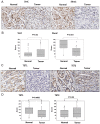Ten-eleven translocation 1 dysfunction reduces 5-hydroxymethylcytosine expression levels in gastric cancer cells
- PMID: 29285192
- PMCID: PMC5738697
- DOI: 10.3892/ol.2017.7264
Ten-eleven translocation 1 dysfunction reduces 5-hydroxymethylcytosine expression levels in gastric cancer cells
Abstract
A sixth base, 5-hydroxymethylcytosine (5hmC), is formed by the oxidation of 5-methylcytosine (5mC) via the catalysis of the ten-eleven translocation (TET) protein family in cells. Expression levels of 5hmC are frequently depleted during carcinogenesis. However, the detailed mechanisms underlying the depletion of 5hmC expression in gastric cancer cells remains unclear, and further research is required. The present study examined the expression levels of 5mC and 5hmC and the expression levels of TET1 and TET2 in gastric cancer tissues using immunohistochemistry. The results revealed that 5hmC expression levels were markedly lower in gastric cancer tissues compared with corresponding adjacent normal tissues. Furthermore, a decrease in 5hmC expression levels was associated with a decrease in TET1 protein expression levels in gastric cancer tissues. The ectopic expression level of TET1 may increase the 5hmC expression level in gastric cancer cells. In addition, the results revealed that TET1 protein expression was markedly different in regards to subcellular localization, and mislocalization was significantly associated with the depletion of 5hmC expression levels in gastric cancer. Together, the results of the present study indicated that TET1 dysfunction reduces 5hmC expression levels, and this phenomenon may serve a crucial role in gastric cancer progression.
Keywords: DNA methylation; demethylation; gastric cancer; hydroxylmethylation.
Figures




Similar articles
-
Distinct roles of the methylcytosine oxidases Tet1 and Tet2 in mouse embryonic stem cells.Proc Natl Acad Sci U S A. 2014 Jan 28;111(4):1361-6. doi: 10.1073/pnas.1322921111. Epub 2014 Jan 13. Proc Natl Acad Sci U S A. 2014. PMID: 24474761 Free PMC article.
-
5-hydroxymethylcytosines regulate gene expression as a passive DNA demethylation resisting epigenetic mark in proliferative somatic cells.bioRxiv [Preprint]. 2023 Sep 27:2023.09.26.559662. doi: 10.1101/2023.09.26.559662. bioRxiv. 2023. PMID: 37808741 Free PMC article. Preprint.
-
Induction of active demethylation and 5hmC formation by 5-azacytidine is TET2 dependent and suggests new treatment strategies against hepatocellular carcinoma.Clin Epigenetics. 2015 Sep 11;7(1):98. doi: 10.1186/s13148-015-0133-x. eCollection 2015. Clin Epigenetics. 2015. PMID: 26366235 Free PMC article.
-
Advances in DNA methylation: 5-hydroxymethylcytosine revisited.Clin Chim Acta. 2011 May 12;412(11-12):831-6. doi: 10.1016/j.cca.2011.02.013. Epub 2011 Feb 12. Clin Chim Acta. 2011. PMID: 21324307 Review.
-
TET Enzymes and 5hmC Levels in Carcinogenesis and Progression of Breast Cancer: Potential Therapeutic Targets.Int J Mol Sci. 2023 Dec 24;25(1):272. doi: 10.3390/ijms25010272. Int J Mol Sci. 2023. PMID: 38203443 Free PMC article. Review.
Cited by
-
Chrysin Induced Cell Apoptosis and Inhibited Invasion Through Regulation of TET1 Expression in Gastric Cancer Cells.Onco Targets Ther. 2020 Apr 20;13:3277-3287. doi: 10.2147/OTT.S246031. eCollection 2020. Onco Targets Ther. 2020. PMID: 32368086 Free PMC article.
-
Neuroprotective Effect of Piracetam against Cocaine-Induced Neuro Epigenetic Modification of DNA Methylation in Astrocytes.Brain Sci. 2020 Sep 5;10(9):611. doi: 10.3390/brainsci10090611. Brain Sci. 2020. PMID: 32899583 Free PMC article.
-
The level of active DNA demethylation compounds in leukocytes and urine samples as potential epigenetic biomarkers in breast cancer patients.Sci Rep. 2024 Mar 18;14(1):6481. doi: 10.1038/s41598-024-56326-5. Sci Rep. 2024. PMID: 38499584 Free PMC article.
-
LINC01089 is a tumor-suppressive lncRNA in gastric cancer and it regulates miR-27a-3p/TET1 axis.Cancer Cell Int. 2020 Oct 16;20:507. doi: 10.1186/s12935-020-01561-9. eCollection 2020. Cancer Cell Int. 2020. PMID: 33088215 Free PMC article.
-
Methylation Dynamics of RASSF1A and Its Impact on Cancer.Cancers (Basel). 2019 Jul 9;11(7):959. doi: 10.3390/cancers11070959. Cancers (Basel). 2019. PMID: 31323949 Free PMC article. Review.
References
LinkOut - more resources
Full Text Sources
Other Literature Sources
Research Materials
